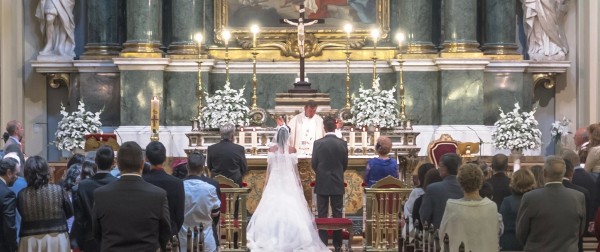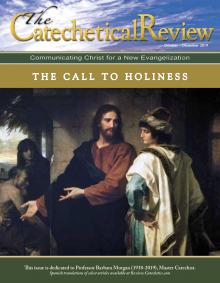
The matrimony of two of the baptized…is in real, essential and intrinsic relationship with the mystery of the union of Christ with the church…it participates in its nature…marriage is deeply seated and rooted therefore in the Eucharistic mystery.[1]
This spiritual vision of marriage, as articulated by Cardinal Caffara, may appear as novel or even bizarre or “cultist” to many younger members of western culture. The defining characteristic for marriage today is that it has no defining characteristic. It is open and runny and borderless. We decide what marriage is, and hence it has devolved from a sacrament to a “private love.” This “love’s” very meaning is malleable, and its connection to procreation and permanence and the divine is severed. Yet for the Catholic Church, marriage is still the primordial mystery, one which reveals God’s love for humanity. This revelation has been consistent from the beginning of the Bible all the way through to the Bridegroom, Christ, giving himself completely upon the cross for the Bride, the Church (Is 62:5; Hos 2:18-20; Jer 3:20; Ez 15:8-15; Mt 22:1-14; 9:14; 22:1-2; 25:1; Eph 5:32). Marriage reveals that God’s own love is free, faithful, forever covenanted, and always life giving. Deep within the suffering of giving and receiving one another in married love God himself is becoming known to the couple. One cannot live such free self-giving in a permanent life-giving way without glimpsing God even in traces, by those, too, who believe marriage is permanent but not a sacrament. For God’s very nature is love, and all true love seeks to freely self-donate in a permanent life-giving way.
Marriage: An Ongoing Encounter with Christ
For the committed Catholic couple, marriage’s true nature has been revealed specifically in the life, death, and resurrection of Christ. And it is into this mystery of Jesus’ own spousal love that all Catholic couples are taken when they consent in Christ to love one another until the end. There is no private meaning to spousal love for Catholic couples as their love transcends themselves from its very beginning. As a sacrament, marriage is an ongoing encounter with the power of Christ’s own life and love. Each couple abides with Christ and is empowered to love through the Holy Spirit. With such a Spirit the couple loves each other with Christ’s own love (CCC 1661).
The cultural and political understanding of marriage as private love is far from this dynamic and sacred understanding of marriage as loving with Christ’s own love. Ending a more superficial and self-defining notion of marriage will only occur through one powerful reality: the witness of Catholic couples who drink deeply of the mystical vision of marriage. By “mystical” I don’t mean a marriage filled with disembodied voices, levitations, or meditative trances. Mystical marriages are grounded in the mysteries of Christ, and these mysteries are communicated most normally and powerfully at the Eucharistic Liturgy. In other words, to live a mystical marriage, which invites the culture to consider a more profound and transcendent understanding of marital love, a couple needs to receive their own marital life from the Eucharist. To have the Eucharist fuel a couple’s love for one another is to be “mystical.”
The Vows Secure Our Freedom to Give
Ultimately, God wants us to fall in love with our spouse in the manner that he loves us: out of sheer gift and in wonder over the beauty of who we are. The spiritual goal of Catholic marriage is for it to be a conduit of grace from God for the mutual conversion of the spouses. The bottom line on the marriage vow is, “I am not going anywhere.” With this vow, and with God’s help, one spouse sees the other spouse through his or her moral and emotional conversion. This vow frees the spouses to live in truth and communicate their struggles with each other. The vow for spouses to stay faithful until death gives each partner the courage to receive the truth about his or her present weaknesses, struggles, and faults without the thought that, “I will be abandoned” (Jn 14:18).
To vow to remain (“Whoever remains in me and I in him will bear much fruit” Jn 15:5) with your spouse until death and then to entrust your heart to, and share your prayers with, your spouse creates the emotional and spiritual security necessary to entrust one’s body to the other. Mature communion between spouses depends upon emotional, spiritual, and physical safety. “I will reveal all only if I am assured you will receive all and not run from me.” In creating such a safe place called marriage, a man and a woman know happiness. Anything less than this kind of safety carries the potential for such happiness but not yet its fullness.
Marital intimacy, then, is a sharing of heart and body within the safety and trust of a prayerful and vowed relationship until death. Much pain is caused by couples who do not bestow intimacy as their primary gift to one another. The human heart longs for intimacy, and when real, is its deepest place of rest. When intimacy is attained within a communion of prayer, it becomes the deepest place of life’s meaning. Without such deep sharing, a couple may simply co-exist in a house, efficiently choosing the most amenable route to accomplish daily duties. But to do so is to miss one another, to live side by side but never truly be in one another’s real presence. To live in the real presence of your spouse requires a commitment to self-revelation. We are invited to reveal our heart and to receive our spouse’s heart, and such reciprocal self-revelation establishes and deepens intimacy. To love is to give and reveal the self for the good of one’s beloved.
Holiness: A Gift to Receive
If Catholic marriage is about giving and receiving the self in Christ until death, then how do couples secure that kind of living in today’s non-supportive culture? Is holiness still possible?
- Holiness is a gift that is given as we cry out to Christ upon his cross. He wants to bestow it upon those who include him in the vows and eschew “private love.”
- This “crying out” is best done in the Eucharistic Liturgy, the very gathering that celebrates and embodies the Bridegroom’s love for his Bride, the Church. As couples participate in this worship, they are surrendering their very marriages to the origin of such love itself—Christ giving himself to the Bride.
- The more we consciously surrender our spousal love to Christ at Mass the more our undue love for self will disintegrate. Our love for our spouse then becomes our secured identity. Each time we receive Holy Communion, unobstructed by mortal sin, we are taken up into the Wedding Feast of the Lamb. Anyone in that state of grace will receive a new power to forget self and remain available to serve the needs of our spouse.
- From this common worship at the Eucharistic Liturgy we become more adept at receiving those graces in personal prayer together at home. Protecting personal prayer with one another as a couple is the ordinary way to deepen our mystical identity. By praying together, we become bored with our sins and seek life to the full in the very sacrament that defines our life’s meaning. Our marriage is taken up in the marriage of the Lamb.
- Finally, marital holiness is secured by committing to communicate with one another each day. In this conversation, we open our hearts, share our thoughts, feelings, and desires with our spouse through common and ordinary conversation. Without this aspect of truly engaging one another each day, engagement with God may fail to move the marital relationship into peace and rest.
Catholic marriage is a holy communion of persons, which lifts the love of the couple up into the powerful way of love that is the life of Christ. He dedicated himself to complete self-giving to his Bride, the Church. But in so loving he knew that this was not a reckless act. His dedication to love was secured by the Father’s love for him and elicited great love in return by the Church herself, beginning with his own Mother, Mary. To give selflessly for the benefit of our spouse is possible because such giving is established upon the all-giving Holy Trinity. To enter their circulation of love within the Sacrament of Marriage is to ensure that spousal love is built upon Love himself.
Deacon James Keating, Ph.D. is Director of Theological Formation in the Institute for Priestly Formation at Creighton University in Omaha, Nebraska. He is married to Marianne and is father of four, grandfather of one. He is author of the best-selling book, Spousal Prayer (IPF Publications, 2016).
Note
[1] Cardinal Carlo Caffara, Remaining in the Truth of Christ, ed. R Dodaro (San Francisco: Ignatius Press, 2014), 171-173.
This article originally appeared on pages 8-9 of the printed edition.
Photo: public domain image from Pixabay.com.
This article is from The Catechetical Review (Online Edition ISSN 2379-6324) and may be copied for catechetical purposes only. It may not be reprinted in another published work without the permission of The Catechetical Review by contacting [email protected]


















